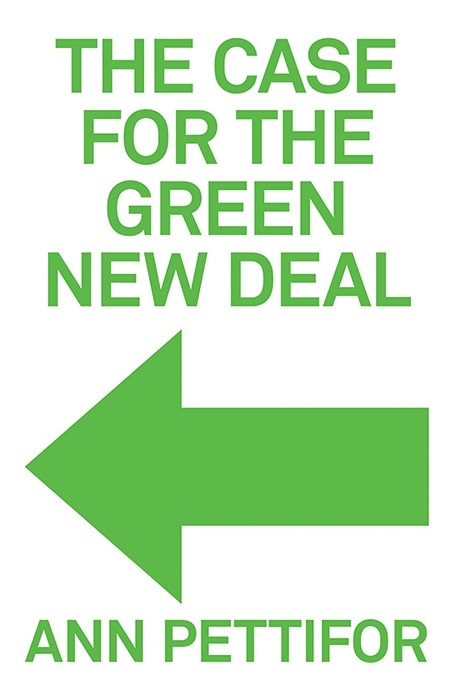“The Case for the Green New Deal”, Book Review

Ann Pettifor, Verso Publishers, 2019
Before reading this present book, one should have a clear understanding what was the “gold standard”, the “invisible hand” and Roosevelt’s 1930’s “New Deal”. This present book title, the “Green” New Deal is partly based on Roosevelt’s ideas. If you are not strongly familiar with those topics, you would benefit from reading one of her previous titles such as The Production of Money or The Coming First World Debt Crisis. Although she does give a little background in this present volume, it is scattered throughout the book and is probably not enough and perhaps a little confusing to those who don’t have a well-developed understanding of the subjects.
To demonstrate her accuracy on the subject and go into even more detail, one could go back further and read the works of the American professor Dr. Carroll Quigley – Tragedy and Hope and on a slightly different but interesting topic, The Evolution of Civilizations.
In this latest offering, Dr. Pettifor argues that finance, the economy and the ecosystem are all tied together, and that global climate problems and carbon emissions are a direct result of a failed economic system.
Overhauling the economy away from fossil fuels means subordinating the finance sector to the interests of society and the planet. In other words, governments must retake control of the financial sector.
Dr. Pettifor considers the monetary system as a public good, and as such should be managed by the visible hand of a public authority, and not the so-called “invisible hand”. In fact, allowing the economy to be managed by private actors is why our other public goods such as water, transport, education, housing and environmental services and health have become privatised. The financial sector has monetised every sphere of collective activity.
Governments at present do not have the power to direct investment towards renewable energy, which would also by nature create more jobs. If instead they regained control over the economy, the public authority (governments) could invest taxpayer money into shifting “our energy needs towards “solar, wind, hydro, ethanol, biodiesel, clean coal and nuclear power…” Government authority could also set limits on the prices of essential services.
It is not clear why Dr. Pettifor included coal and nuclear power in her list of “green” energies. “Clean” coal means capturing carbon emissions from burning coal and burying them in the earth. Nuclear power produces radioactive waste that is also buried in the ground. Neither of these options seem to be beneficial for the environment.
The other side of this Green New Deal reveals itself
Dr. Pettifor states that just “10% of the global population are responsible for around 50% of total emissions. Tackling the consumption and aviation habits of just 10% of the global population should help drive down 50% of total emissions in a very short time.”
However, she also states that ecological “justice” requires a major redistribution of wealth from rich countries to poor countries. If rich countries cut their emissions, why do they also have to “distribute” their wealth?
Dr. Pettifor should know that throwing money at poor countries won’t make them rich. She was primarily responsible for having the Paris Club, IMF and World Bank collectively cancel about $100 billion in debt from 35 of the poorest countries, mostly in Africa. What was the result, to her surprise? As soon as those countries were made more sustainable, the IMF and the World Bank followed up with new loans.
It is unfortunate that there is this unnecessary drift into global Socialism that pervades the first half of her book. Red flags include the necessity for “radical” action; “revolution”; treating climate breakdown as a security threat to the nation as a whole (as if the nation were facing the threat of war).
She also takes a few jabs at Capitalism: “Capitalism depends on a system enriched by imperialism, racism and sexism.” A capitalist economy “deliberately depletes the earth’s finite resources”. She often quotes Socialist George Monbiot, who refers to capitalism as a “spirit-crushing and society-crushing” system.
This is where the observations of Carroll Quigley are helpful. He had noted that in the late 1800’s/early 1900’s, people who appeared uninventive in Eastern European countries suddenly became inventive once they came to [capitalist] America. Eastern European countries at that time certainly weren’t capitalist, but they were apparently spirit-crushing.
 Dr. Pettifor has a lot of good ideas in the book. Clean energy would bring plenty of new jobs and industry, and governments should take back control of and strongly regulate the financial sector, just as all other areas of life are regulated. There should be no such thing as an “off shore” company – where your business or main office operates is where your business is located. To do otherwise is tax avoidance. There should also be less emphasis on the global economy and more emphasis on the local economy. Capital mobility should be better regulated and limited – this would make criminal activity more visible.
Dr. Pettifor has a lot of good ideas in the book. Clean energy would bring plenty of new jobs and industry, and governments should take back control of and strongly regulate the financial sector, just as all other areas of life are regulated. There should be no such thing as an “off shore” company – where your business or main office operates is where your business is located. To do otherwise is tax avoidance. There should also be less emphasis on the global economy and more emphasis on the local economy. Capital mobility should be better regulated and limited – this would make criminal activity more visible.
In the second half of her book, she outlines various principles to be followed. Although these ideas might seem like a step back in history, many are plausible ideas that can be utilised to return economies and the environment back to a healthy state. The idea of limitless wants and infinite expansion should to be reined in.
Overall, The Case for the Green New Deal is a good and sometimes challenging read. It may help to answer many questions about the economy and energy and what can be done to “save our planet”. Dr. Pettifor is also very well aware of the many challenges to her plan, including the simple lack of courage prevalent in our government leaders. She also has revealed a Socialist ideology that may influence our repair of the earth’s ecosystem. One can have socialist ideas – Medicare for all, for example, and not be an idealist Socialist. National or Global Socialism is not the only way in which a Green New Deal can be accomplished. After all, Roosevelt saw ideology as something to fear, not embrace.







